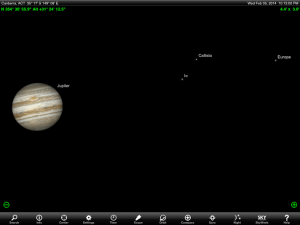Posted 31 January 2014 Look low above the Northern horizon tonight this Wednesday (5 February 2014) as soon as the sky is dark and you will notice a dazzling bright star. Point even a very small telescope at the ‘star’ and you will discover that you are looking at the largest planet in our solar system, Jupiter.
Look at Jupiter Wednesday night (5 February 2014) to see the largest storm in our solar system, the Great Red Spot. Not only is is it a very old storm (hundreds of years), it is very large at about 12,000 by 25,000 km and is big enough to hold two Earths. Sadly the colour has faded in the last few years and it should really be called the Great Salmon Spot!
Note that the larger your telescope, the easier it will be to see the Great Red Spot. I have an eight inch dobsonian telescope and I find it difficult to see it – even though I know what I am looking for.
Given that Jupiter rotates approximately every 9 hours and 50 minutes, you have to know when to look for it. I use this handy webpage which calculates what astronomers the Great Red Spot’s transit times (i.e. when it passes across the face of Jupiter as seen from Earth). For Wednesday night (5 February 2014), it transits at 10:13 pm AEST / 11:13 pm AEDT.
